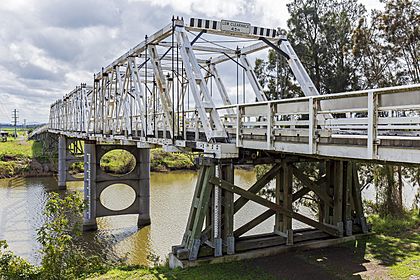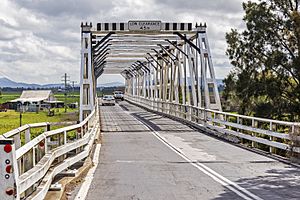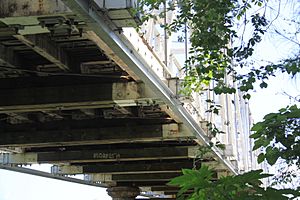Morpeth Bridge facts for kids
Quick facts for kids Morpeth Bridge |
|
|---|---|

Morpeth Bridge in September 2019
|
|
| Coordinates | 32°43′26″S 151°37′36″E / 32.7238°S 151.6266°E |
| Crosses | Hunter River |
| Locale | Morpeth, City of Maitland, New South Wales, Australia |
| Owner | Roads and Maritime Services |
| Characteristics | |
| Design | Allan truss |
| Material | Iron, Wood |
| Trough construction | Iron cylinders |
| Total length | 820 ft (250 m) |
| Longest span | 3× 110 ft (34 m) + numerous 35 ft (11 m) |
| Number of spans | 1 + 3 main + 15 |
| Piers in water | 2 |
| Clearance above | 12 ft (3.8 m) |
| History | |
| Designer | Percy Allan |
| Constructed by | Samuel McGill |
| Fabrication by | Mort's Dock—bridge cylinders |
| Construction begin | 1896 |
| Construction end | 1898 |
| Construction cost | A£8,260 |
| Opened | 15 June 1898 |
The Morpeth Bridge is an old road bridge in Morpeth, Australia. It crosses the Hunter River. This bridge is special because it's a heritage-listed site, meaning it's protected for its historical importance.
The bridge was designed by Percy Allan and built by Samuel McGill between 1896 and 1898. It opened on June 15, 1898. The Morpeth Bridge is made of timber and uses a special design called an Allan truss. It also has two main supports made of iron cylinders. Today, the Roads and Maritime Services looks after the bridge.
Contents
History of Morpeth Bridge
Morpeth started as a small town on the Hunter River. In the 1830s, it grew into a busy river port. It became an important center for farming and industry in the Hunter Valley. Before the bridge, people crossed the river using a "punt service." This was like a small ferry pulled across the water.
Why the Bridge Was Needed
People in Morpeth really wanted a bridge over the Hunter River. They started asking for it in 1885. Local leaders felt a bridge would help connect Morpeth with nearby towns like Phoenix Park and Hinton. They believed it would make travel much easier for everyone in the area.
In 1896, the government asked companies to bid on building the bridge. They wanted a timber bridge with iron supports. Samuel McGill won the bid to build it. The bridge was expected to cost about £9,000.
Building the Bridge
Building the bridge wasn't easy. In February 1897, floods along the Hunter River caused problems. The floods washed away some of the scaffolding used for construction. Despite these delays, the bridge was finished. The final cost was a bit more than expected, around £9,239.
The Morpeth Bridge officially opened in June 1898. It replaced the old hand-powered punt. Many important people, including politicians, came to the opening ceremony. There was also a brass band and a parade of schoolchildren. Everyone agreed it was a fun and successful day.
How the Bridge Was Built
The bridge had three main timber sections, each about 30 meters (100 feet) long. These sections rested on strong iron supports in the river. There were also 14 smaller timber sections, each about 10 meters (35 feet) long, leading up to the main part. The road on the bridge was about 5.5 meters (18 feet) wide. The bridge was built high enough, about 5 meters (16 feet) above flood level, to clear a local tramway.
The government saw the bridge as a very important project. It helped connect Morpeth to the low-lying areas of Phoenix Park.
What Morpeth Bridge Looks Like
The Morpeth Bridge has three large timber sections called Allan trusses. These trusses are supported by strong iron cylinders in the river. The parts of the bridge leading up to the main sections are made of timber beams. The road on the bridge is about 5.5 meters (18 feet) wide.
Allan Truss Design
The Allan truss design was special for its time. It used pairs of timber pieces throughout the bridge. This meant that if one part needed fixing, it could be replaced without closing the whole bridge. The design also used strong metal rods to hold the timber pieces together. These rods could be adjusted to keep the bridge strong.
Percy Allan's design was lighter and cheaper to build than older bridge designs. It was also easier to paint and repair. The design used shorter pieces of timber, which were easier to find and move during construction.
There are also special stairs on the northern side of the bridge. These stairs are for people to use to get to higher ground during floods.
Changes Over Time
Over the years, some parts of the bridge have been replaced. This is normal for old timber bridges. However, the bridge still looks mostly like it did when it was first built.
Between 2008 and 2011, the bridge was updated to handle heavier traffic. The old timber road surface was replaced with new materials. The original timber railings were also replaced with steel ones that look similar but are safer. Some of the northern approach sections were replaced with a raised earth bank and concrete walls. The flood evacuation stairs were also moved to a different spot in 2013.
Why Morpeth Bridge is Important
The Morpeth Bridge is a very important historical structure. It's a great example of an Allan type timber truss road bridge. It has been a key river crossing since it was built in 1898. The bridge also shows how the road network and economy grew in New South Wales. It's also linked to its designer, Percy Allan, who was a famous bridge engineer.
Special Design Features
Allan trusses were a big improvement in bridge design. They were cheaper to build and could carry more weight than older designs. They were also easier to maintain. Only a few of these special overhead braced Allan bridges were built, and even fewer are still standing today. They were considered the best timber bridges built in Australia at the time.
The Morpeth Bridge is also important for its beauty. It's a striking and unique building in the town of Morpeth. It fits well with the town's historic look. The flood evacuation stairs on the northern side are also a unique feature.
Heritage Listing Reasons
The Morpeth Bridge was added to the New South Wales State Heritage Register in 2000 for several reasons:
- Historical Importance: The bridge shows how the road network grew in New South Wales. It also shows how Australian engineers started using American design ideas. It's connected to Percy Allan, a very important bridge designer. The bridge also complements the historic town of Morpeth.
- Connection to Important People: The bridge exists because the local community worked hard to get it built. It was built by S. McGill, who also built other important bridges nearby. Percy Allan, who designed the bridge, designed many bridges during his long career.
- Design and Technical Skill: The bridge shows excellent design and construction. It's a strong and noticeable building in Morpeth. Its design was a major technical achievement for its time.
- Community Value: Timber truss bridges are well-known in New South Wales. This bridge is important to the local community. It helped the area grow and provided a permanent link between Morpeth and other towns. The community fought hard to have it built.
- Research Potential: The Morpeth Bridge is important for understanding how timber truss bridges developed. It's one of only a few large Allan truss bridges left with its full overhead bracing. It's also the only triple-span Allan truss bridge of its kind that doesn't have a lift span.
- Rarity: Out of 104 Allan trusses built, only 24 still exist in New South Wales. The Morpeth Bridge is one of only six large Allan truss bridges with full overhead bracing that were built, and only two of these are still open to traffic. Its unique flood evacuation stairs also make it special among bridges in the Hunter Valley.
- Good Example: The bridge is a great example of this type of timber truss bridge, which was rarely built in Australia. The flood evacuation stairs also show how farmers in the area dealt with frequent floods.
Images for kids






